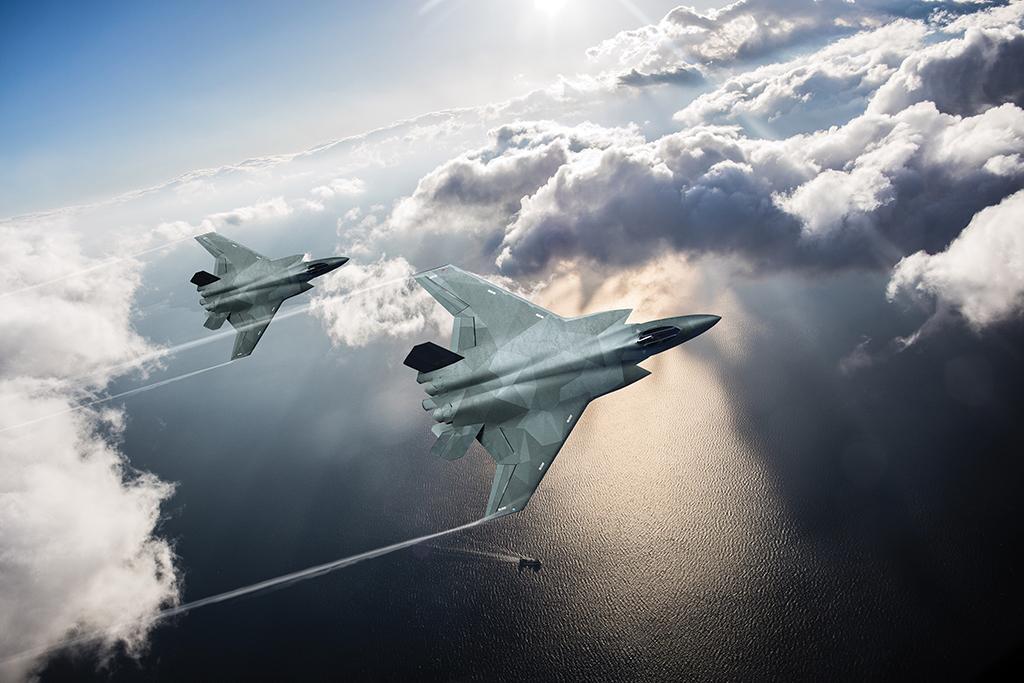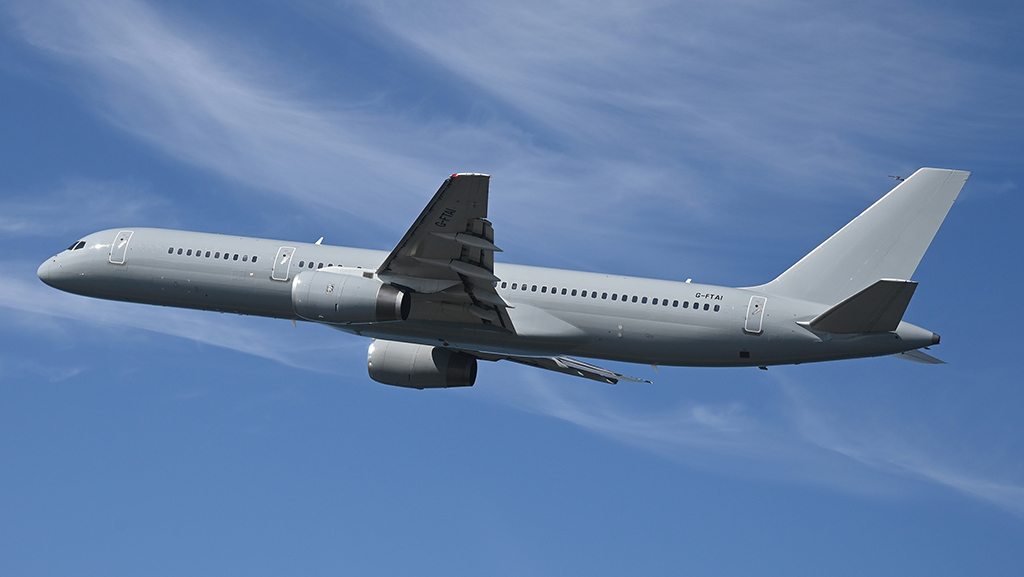
New artist’s impressions of the GCAP fighter, referred to as the Tempest in the UK, indicate the platform configuration is firming up as industry determines how best to deliver the program.
Industry partners in the trinational Global Combat Air Program are mapping out the likely allocation of responsibilities in their joint development of a sixth-generation combat aircraft.
Ahead of the design and development contract expected to be issued by the governments of Italy, Japan and the UK in 2025, industry is being challenged to find the best way to deliver the program to meet the 2035 service entry timeline.
- Program pace and modification requirements drive push for collaborative development
- Sensor suite high-level design completed and reviewed
- GCAP industrial partners signed trilateral agreements ahead of DSEI defense expo
These efforts are taking place behind the scenes as the lead systems and subsystems integrators in the program announce they have made trilateral agreements to enhance cooperation and share information, all just 10 months after the formal launch of the Global Combat Air Program (GCAP) initiative last December.
The program aims to develop a supersonic, low-observable combat aircraft that could replace the Eurofighter Typhoons operated by Italy and the UK and the Mitsubishi F-2s operated by Japan.
The timelines are tight. They have just two years to begin work and then meet the 2035 entry-into-service target. That would then be followed by five years of so-called rapid spiral updates to ready the fighter for the front line.
“We have challenged our industry partners to work out how best to do as much as possible jointly to support the affordability and efficiency pace of the program,” Richard Berthon, the UK defense ministry’s director of future combat air, told Aviation Week at the Defense and Security Equipment International (DSEI) conference in London on Sept 12.
“They are discussing now what it is that each of the companies brings to the party—skills, technology, facilities and so on—and they are defining how they think the program can best be delivered,” he adds.
Gone, Berthon said, is a setup, such as with the Eurofighter program, in which the work was divided four ways and—not always efficiently—allocated to the different countries.
Also not being considered this time is the principle of “best athlete,” under which the most skilled or most capable industry leads on a certain element of the program.
The GCAP approach is somewhere in the middle, industry officials say. Some work will be done in the traditional supply chain sense, they say, contracted to industry in each of the three partner nations. But otherwise the aim is for joint teams from across program areas, such as sensors, power systems, airframe and weapons integration to work together wherever they are in the world.

Officials are confident about this nontraditional approach. Japanese officials describe how, through a digital workflow, any work unfinished at the end of the day in Japan can be completed by colleagues in Italy and the UK and vice versa, due to the different time zones.
Berthon said the approach would allow the GCAP program to meet not only the affordability and efficiency targets but also the ambitions for freedom of action and modification that are at the heart of the program and that the partner nations struggled with through their acquisition of the Lockheed Martin F-35.
Industry and government officials accept that there may be some areas where working jointly might not be possible. Some partners might not want to share hard-fought industrial capabilities and sensitive technologies with the other nations or may want to use their own onshore capabilities even if they might have to pay more for that option. Berthon said such decisions must be respected. “There is a reason these countries are doing this program and not just buying off the shelf, and that is because their sovereignty is so important,” he said.
One area of the GCAP’s joint work that is apparently progressing—at least publicly—is development of the aircraft’s Integrated Sensing and Non-Kinetic Effects (Isanke) and Integrated Communications System (ICS) suite. It is being developed by Leonardo’s electronics units in the UK and Italy, Italy’s ELT Group and Japan’s Mitsubishi Electric. Leonardo UK and Mitsubishi had already partnered around the development of the Jaguar radar antenna. With the new industry partners onboard, they have now agreed on the high-level design of the Isanke and ICS systems, including what their key elements would be and where they might be distributed across the airframe.
A three-nation systems review was also completed in recent weeks. Moreover, the companies have recently been “assessing a number of alternative operational and commercial models” to deliver the Isanke capability, Andrew Howard, director of future combat air at Leonardo UK, revealed during an Isanke forum at DSEI.
Jointly the four companies state they are getting closer to identifying “the most efficient and effective way of delivering the program at pace,” Howard said.
DSEI also saw the UK and Italian businesses of MBDA sign agreements with Mitsubishi Electric about weapons integration and collaboration, but there are no plans for joint weapons development.
The GCAP appears to be backed by stable funding. The UK has proposed a budget of £12 billion ($14.8 billion) over 10 years, Annabel Goldie, minister of state for defense, told Parliament. Brig. Gen. Luca De Martinis, director of armament programs coordination for the Italian Defense Ministry, told a forum of GCAP leaders at DSEI that his country had made a “political commitment” for the program with financing for 15 years at a “level of funding we estimate at the moment that we need to sustain the program.”
How industry decides to best deliver its work into the GCAP is a separate issue from the planned international government structure that would manage the program. This management organization will likely be formed through a trilateral treaty, officials close to the program say.
Development of this management body has been the subject of about nine months of meetings, with officials from all three governments working on the organizational structure, the skill sets required and where it will be headquartered—a decision so far undisclosed.
Berthon has described this organization as more “empowered” than those previously charged with managing multinational programs. The aim is to bring together procurement personnel and engineers from all three nations into a single organization, eliminating the need for separate government agencies from each nation attempting to run the project.
Despite the progress, much remains to be done ahead of the 2025 contract, and questions remain about intellectual property. That is an issue that dogged progress on the Franco-German-Spanish Future Combat Air System (FCAS) last year and caused a year of delays.
There is also an ongoing debate among the GCAP nations about their willingness to export the platform. Recent media reports from London have suggested that Japan in particular is uncomfortable with possible Saudi Arabian involvement in the GCAP initiative.
That issue was highlighted after the signing in March between London and Riyadh of a yearlong feasibility study about their combat air relationship. The UK has a long history of supplying combat aircraft to Saudi Arabia, from the English Electric Lightning to the Eurofighter Typhoon. And with the emergence of the GCAP and Riyadh’s own Vision 2030 ambitions, Saudi Arabia has shown significant interest in joining the initiative. But it is unclear what the country’s still fledgling aerospace and defense industry could contribute at this stage, apart from its deep pockets.
Furthermore, with the three-nation partnership maturing its plans, it seems unlikely to be able to accommodate more entrants. But there may be other options, Berthon seemed to suggest.
“The [results] of the study will give us a clear understanding of [Saudi] ambitions and more of an understanding about what they would wish to get out of a future partnership,” Berthon said. “I am confident that there is an exciting partnership opportunity through the GCAP, not just with the Saudis but with other countries as well.” He added that the talks would continue.
The three GCAP nations are hopeful the fighter aircraft that emerges would have the benefit of being a first mover in the market for a new-generation fighter, officials said this past summer, suggesting they could generate several hundred export sales of the platform.
Other sixth-generation offerings, such as the U.S.’ Next-Generation Air Dominance program, are likely to result in a platform that would be unavailable for export due to technology sensitivities and a high price tag, while the European FCAS is not expected to arrive until 2040—after the GCAP aircraft.





